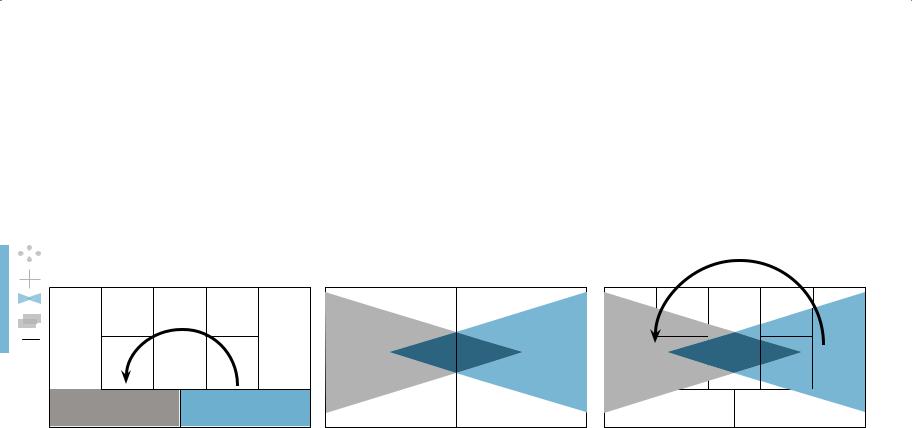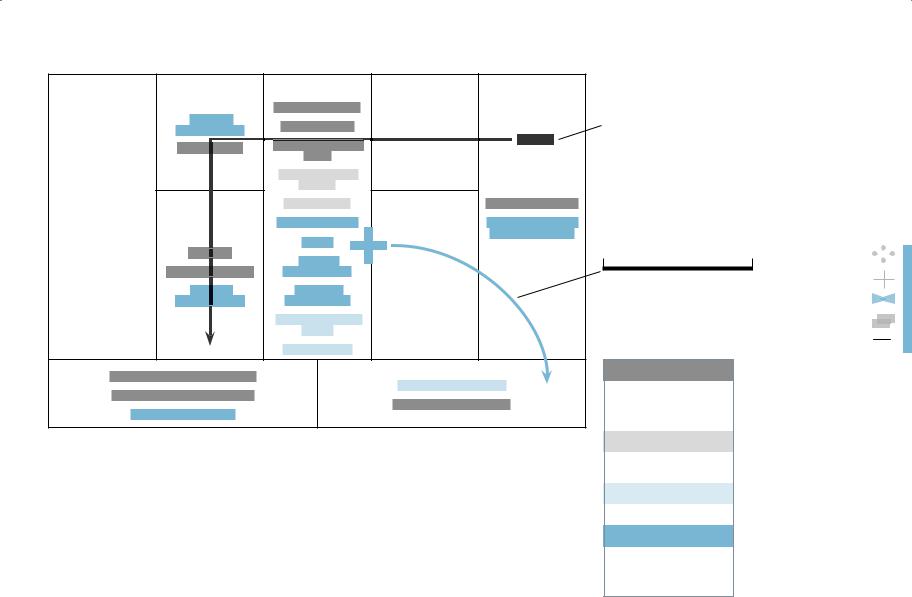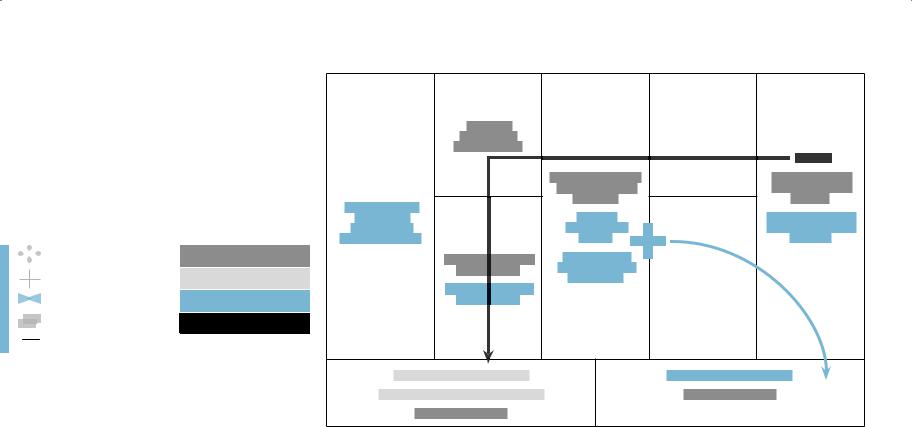

business model perspective on blue ocean strategy
In this section we blend our business model tools with the
Blue Ocean Strategy concept coined by Kim and Mauborgne in their million-selling book of the same name. The Business Model Canvas is a perfect extension of the analytical tools presented by Kim and Mauborgne. Together they provide a powerful framework for questioning incumbent business models and creating new, more competitive models.
Blue Ocean Strategy is a potent method for questioning Value Proposi-
226tions and business models and exploring new Customer Segments. The Business Model Canvas complements Blue Ocean by providing a visual
“big picture” that helps us understand how changing one part of a business model impacts other components.
In a nutshell, Blue Ocean Strategy is about creating completely new industries through fundamental differentiation as opposed to competing in existing industries by tweaking established models. Rather than outdoing competitors in terms of traditional performance metrics, Kim and Mauborgne advocate creating new, uncontested market space through what the authors call value innovation. This means increasing value for customers by creating new benefits and services, while simultaneously reducing costs by eliminating less valuable features or services. Notice how this approach rejects the traditionally accepted trade-off between differentiation and lower cost.
To achieve value innovation, Kim and Mauborgne propose an analytical tool they call the Four Actions Framework. These four key questions challenge an industry’s strategic logic and established business model:
1.Which of the factors that the industry takes for granted should be eliminated?
2.Which factors should be reduced well below the industry standard?
3.Which factors should be raised well above the industry standard?
4.Which factors should be created that the industry has never offered?
In addition to value innovation, Kim and Mauborgne propose exploring non-customer groups to create Blue Oceans and tap untouched markets.
Blending Kim and Mauborgne’s value innovation concept and Four Actions Framework with the Business Model Canvas creates a powerful new tool. In the Business Model Canvas the right-hand side represents value creation and the left-hand side represents costs. This fits well with Kim and Mauborgne’s value innovation logic of increasing value and reducing costs.

|
|
|
|
|
|
|
|
|
|
|
|
|
eliminate |
|
|
|
|
|
|
|
|
|
|
|
raise |
|
|
|
|
|
|
|
|
|
|
||||||||||||||||||||||||||||||||||||||||
|
|
|
|
|
|
|
|
|
|
|
|
|
|||||||||||||||||||||||||||||||||||||||||||||||||||||||||||||||
|
|
|
|
which factors can you |
which factors should |
|
|
|
|
|
|
|
|
|
|
||||||||||||||||||||||||||||||||||||||||||||||||||||||||||||
|
|
|
|
|
|
|
|
|
|
|
|
|
|
||||||||||||||||||||||||||||||||||||||||||||||||||||||||||||||
|
|
|
|
|
|
|
|
|
|
|
|
|
|
||||||||||||||||||||||||||||||||||||||||||||||||||||||||||||||
|
|
|
|
|
|
|
|
|
|
|
|
|
|
||||||||||||||||||||||||||||||||||||||||||||||||||||||||||||||
|
|
|
|
|
|
|
|
|
|
|
|
|
|
||||||||||||||||||||||||||||||||||||||||||||||||||||||||||||||
|
|
|
|
|
|
|
|
|
|
|
|
|
|||||||||||||||||||||||||||||||||||||||||||||||||||||||||||||||
– costs |
+ value |
|
|
eliminate that your indus- |
be raised well above the |
|
|
|
|
|
|
|
|
|
|
||||||||||||||||||||||||||||||||||||||||||||||||||||||||||||
|
|
|
|
|
|
|
|
|
|
|
|||||||||||||||||||||||||||||||||||||||||||||||||||||||||||||||||
|
|
|
|
|
|
|
|
|
|
|
|||||||||||||||||||||||||||||||||||||||||||||||||||||||||||||||||
|
|
try has long competed on? |
industry's standard? |
|
|
|
|
|
|
|
|
|
|
||||||||||||||||||||||||||||||||||||||||||||||||||||||||||||||
|
|
|
|
|
|
|
|
|
|
|
|
|
|
||||||||||||||||||||||||||||||||||||||||||||||||||||||||||||||
|
|
|
|
|
|
|
|
|
|
|
|
|
|
|
|
|
|
|
|
|
|
|
|
|
|
|
|
|
|
|
|
|
|
|
|
|
|
|
|
|
|
|
|
|
|
|
|
|
|
|
|
|
|
|
|
|
|
|
|
|
|
|
|
|
|
|
|
|
|
|
|
|
|
|
|
|
|
|
|
|
|
|
|
|
|
|
|
|
|
|
|
|
|
|
|
|
|
|
|
|
|
|
|
|
|
|
|
|
|
|
|
|
|
|
|
|
|
|
|
|
|
|
|
|
|
|
|
|
|
|
|
|
|
|
|
|
|
|
|
|
|
|
|
|
|
|
|
|
|
|
|
|
|
|
|
|
|
|
|
|
|
|
|
|
|
|
|
|
|
|
|
|
|
|
|
|
|
|
|
|
|
|
|
|
|
|
|
|
|
|
|
|
|
|
|
|
|
|
|
|
|
|
|
|
|
|
|
|
|
|
|
|
|
|
|
|
|
|
|
|
|
|
|
|
|
|
|
|
|
|
|
|
|
|
|
|
|
|
|
|
|
|
|
|
|
|
|
|
|
|
|
|
|
|
|
|
|
|
|
|
|
|
|
|
|
|
|
|
|
|
|
|
|
|
|
|
|
|
|
|
|
|
|
|
|
|
|
|
|
|
|
|
|
|
|
|
|
|
|
|
|
|
|
|
|
|
|
|
|
|
|
|
|
|
|
|
|
|
|
|
|
|
|
|
|
|
|
|
|
|
|
|
|
|
|
|
|
|
|
|
|
|
|
|
|
|
|
|
|
|
|
|
|
|
|
|
|
|
|
|
|
|
|
|
|
|
|
|
|
|
|
|
|
|
|
|
|
|
|
|
|
|
|
|
|
|
|
|
|
|
|
|
|
reduce |
|
|
|
|
|
|
|
|
|
|
create |
|
|
227 |
|
|
|||||||||||||||||||||||||||||||||||||||||||||
|
|
|
|
|
|
|
|
|
|
|
|
|
|
|
|
|
|
|
|
|
|
|
|
|
|
|
|||||||||||||||||||||||||||||||||||||||||||||||||
|
|
|
|
|
|
|
|
|
|
|
|
|
|
|
|
|
|
|
|
|
|
|
|
|
|
|
|
|
|
|
|
|
|
||||||||||||||||||||||||||||||||||||||||||
|
|
|
|
|
|
|
|
|
|
|
|
|
|||||||||||||||||||||||||||||||||||||||||||||||||||||||||||||||
|
|
|
|
|
|
|
|
|
|
|
|
|
|
|
|
|
|
|
|
|
|
|
|
|
|
|
|
|
|
|
|
|
|
||||||||||||||||||||||||||||||||||||||||||
|
|
|
|
which factors should be |
which factors should be |
|
|
|
|
|
|
|
|
|
|
||||||||||||||||||||||||||||||||||||||||||||||||||||||||||||
|
|
|
|
|
|
|
|
|
|
|
|
|
|
||||||||||||||||||||||||||||||||||||||||||||||||||||||||||||||
|
|
|
|
|
|
|
|
|
|
|
|
|
|
||||||||||||||||||||||||||||||||||||||||||||||||||||||||||||||
|
|
|
|
|
|
|
|
|
|
|
|
|
|
||||||||||||||||||||||||||||||||||||||||||||||||||||||||||||||
|
|
|
|
|
|
|
|
|
|
|
|
|
|||||||||||||||||||||||||||||||||||||||||||||||||||||||||||||||
|
|
|
|
|
|
|
|
|
|
|
|
|
|||||||||||||||||||||||||||||||||||||||||||||||||||||||||||||||
|
|
|
|
reduced well below the |
created that the industry |
|
|
|
|
|
|
|
|
|
|
||||||||||||||||||||||||||||||||||||||||||||||||||||||||||||
|
|
|
|
|
|
|
|
|
|
|
|
|
|||||||||||||||||||||||||||||||||||||||||||||||||||||||||||||||
|
|
|
|
industry's standard? |
has never offered? |
|
|
|
|
|
|
|
|
|
|
||||||||||||||||||||||||||||||||||||||||||||||||||||||||||||
|
|
|
|
|
|
|
|
|
|
|
|
|
|||||||||||||||||||||||||||||||||||||||||||||||||||||||||||||||
|
|
|
|
|
|
|
|
|
|
|
|
|
|||||||||||||||||||||||||||||||||||||||||||||||||||||||||||||||
|
|
|
|
|
|
|
|
|
|
|
|
|
|
|
|
|
|
|
|
|
|
|
|
|
|
|
|
|
|
|
|
|
|
|
|
|
|
|
|
|
|
|
|
|
|
|
|
|
|
|
|
|
|
|
|
|
|
|
|
|
|
|
|
|
|
|
|
|
|
|
|
|
|
|
|
|
|
|
|
|
|
|
|
|
|
|
|
|
|
|
|
|
|
|
|
|
|
|
|
|
|
|
|
|
|
|
|
|
|
|
|
|
|
|
|
|
|
|
|
|
|
|
|
|
|
|
|
|
|
|
|
|
|
|
|
|
|
|
|
|
|
|
|
|
|
|
|
|
|
|
|
|
|
|
|
|
|
|
|
|
|
|
|
|
|
|
|
|
|
|
|
|
|
|
|
|
|
|
|
|
|
|
|
|
|
|
|
|
|
|
|
|
|
|
|
|
|
|
|
|
|
|
|
|
|
|
|
|
|
|
|
|
|
|
|
|
|
|
|
|
|
|
|
|
|
|
|
— value innovation — |
— four actions framework — |
Source: Adapted from Blue Ocean Strategy.

blending the blue ocean strategy framework with the business model canvas
Business Model Canvas |
Value innovation |
Blending approaches |
|
eliminate |
raise |
228 |
+ –costs |
+value |
|
||
|
reduce |
create |
cost-side |
value-side |
|
cost |
value |
= implications |
creation |
The Business Model Canvas consists of a right-hand value and customer-focused side, and a left-hand cost and infrastructure side, as descibed earlier (see p. 49). Changing elements on the right-hand side has implications for the left-hand side. For example, if we add to or eliminate parts of the Value Proposition, Channels, or Customer Relationship Building Blocks, this will have immediate implications for Resources, Activities, Partnerships, and Costs.
Blue Ocean Strategy is about simultaneously increasing value while reducing costs. This is achieved by identifying which elements of the Value Proposition can be eliminated, reduced, raised, or newly created. The first goal
is to lower costs by reducing or eliminating less valuable features or services. The second goal is to enhance or create high-value features or services that do not significantly increase the cost base.
Blending Blue Ocean Strategy and the Business Model Canvas lets you systematically analyze a business model innovation in its entirety. You can ask the Four Actions Framework questions (eliminate, create, reduce, raise) about each business model Building Block and immediately recognize implications for the other parts of the business model, (e.g. what are the implications for the cost side when we make changes on the value side? and vice versa).

cirque du soleil
KP |
KA |
VP |
CR |
CS |
|
|
artistic |
star performers |
|
|
|
|
animal shows |
|
|
||
|
development |
|
|
||
|
|
|
|
||
|
animal |
|
|
|
|
|
KR |
|
|
on families |
|
|
|
|
on theater |
||
|
|
|
|
||
|
|
|
|
opera visitors |
|
|
animals |
refined |
|
|
|
|
star performers |
|
|
||
|
environment |
|
|
||
|
refined |
mutliple |
|
|
|
|
environment |
productions |
|
|
|
|
|
artistic music & |
|
|
|
|
|
dance |
|
|
|
|
|
unique venue |
|
|
|
C$ |
costly animal maintenance |
R$ |
ticket price increase |
||
costly star performer fees |
|||||
|
|
aisle concession sales |
|||
|
artistic production |
|
|||
|
|
|
|
||
Cirque du Soleil features prominently among Blue Ocean Strategy examples. Next we apply the blended Blue Ocean and Business Model Canvas approach to this intriguing and highly successful Canadian business.
First, the Four Actions Framework shows how Cirque du Soleil “played” with the traditional elements of the circus business Value Proposition. It eliminated costly elements, such as animals and star performers, while adding other elements, such as theme, artistic atmosphere, and
refined music. This revamped Value Proposition allowed Cirque du Soleil to broaden its appeal to theatergoers and other adults seeking sophisticated entertainment, rather than the traditional circus audience of families.
As a consequence, it was able to substantially raise ticket prices. The Four Actions Framework, outlined in blue and gray in the business model canvas above, illustrates the effects of changes in the Value Proposition.
adding the artistic |
|
|
element to the value |
|
eliminating animals from |
proposition changes |
|
the show substantially |
activities & costs |
|
reduces costs |
|
|
|
|
|
|
the value proposition combines elements from circus, theater & opera, which allows catering to higher end customers who pay higher ticket prices
229
eliminate
star performers animal shows
aisle concession sales multiple show arenas
reduce
fun & humor thrill & danger
raise
unique venue
create
theme refined environment multiple productions artistic music & dance
Source: Adapted from Blue Ocean Strategy.

nintendo’s wii |
|
|
|
|
|
KP |
|
KA |
VP |
CR |
CS |
|
|
state of |
|
|
|
|
|
the art chi |
|
|
|
|
|
development |
|
|
|
|
game |
|
|
|
market |
developers |
|
|
|
“hardcore” |
|
off-the-shelf |
KR |
|
|
gamers |
|
|
|
market of |
|||
hardware |
|
|
|||
component |
|
|
|
gamers & |
|
manufacturers |
|
|
|
families |
|
eliminate |
|
new proprietary |
group (family) |
|
game developers |
reduce |
|
technology |
|
retail |
|
|
|
experience |
|
||
create |
|
motion control |
|
distribution |
|
|
technology |
|
|
|
|
unchanged |
|
|
|
|
|
230 |
|
|
R$ |
|
|
C$ |
console production price |
profit on console sales |
|||
|
|
||||
|
technology development costs |
|
|
console subsidies |
|
|
console subsidies |
|
royalties from game developers |
||
We’ve discussed Nintendo’s successful Wii game console as an example of a multi-sided platform business model pattern (see p. 76). Now we look at how Nintendo differentiated itself from competitors Sony and Microsoft from the standpoint of Blue Ocean Strategy. Compared to Sony’s PlayStation 3 and Microsoft’s Xbox 360, Nintendo pursued a fundamentally different strategy and business model with Wii.
The heart of Nintendo’s strategy was the assumption that consoles do not necessarily require leading-edge power and performance. This was a radical stance in an industry that traditionally competed on technological
performance, graphic quality, and game realism: factors valued primarily by diehard gaming fans. Nintendo shifted its focus to providing a new form of player interaction targeted at a wider demographic than the traditional avid gamer audience. With the Wii, Nintendo brought to market a console that technologically underperformed rival machines, but boosted the fun factor with new motion control technology. Players could control games through a sort of “magic wand,” the Wii Remote, simply through physical movement. The console was an instant success with casual gamers, and outsold rival consoles focused on the traditional market of “hardcore” gamers.
Nintendo’s new business model has the following characteristics: A shift in focus from “hardcore” to casual gamers, which allowed the company to reduce console performance and add a new element of motion control that created more fun; elimination of state-of-the-art chip development and increased use of off-the-shelf components, reducing costs and allowing lower console prices; elimination of console subsidies resulting in profits on each console sold.

questioning your canvas with the four actions framework
The combination of Blue Ocean Strategy tools and the Business Model Canvas provide a solid foundation upon which to question your business model from value creation, customer, and Cost Structure perspectives. We propose that three different perspec- tives—the Customer Segment perspective, the Value Proposition perspective, and the
cost perspective—provide ideal starting points from which to start questioning your business model using the Four Actions Framework. Changes to each starting point then allow you to analyze impacts on other areas of the Business Model Canvas (see also innovation epicenters on p. 138).
Cost Impact Exploration
eliminate |
? |
reduce |
|
raise |
|
create |
|
Identify the highest cost infrastructure elements and evaluate what happens if you eliminate or reduce them. What value elements disappear, and what would you have to create to compensate for their absence? Then, identify infrastructure investments you may want to make and analyze how much value they create.
•Which activities, resources, and partnerships have the highest costs?
•What happens if you reduce or eliminate some of these cost factors?
•How could you replace, using less costly elements, the value lost by reducing or eliminating expensive resources, activities, or partnerships?
•What value would be created by planned new investments?
Exploring Value Proposition Impact Exploring Customer Impact
|
|
|
eliminate |
|
|
|
|
|
|
|
|
|
eliminate |
|
|
|
|
|
|
|
|
|
|||
|
|
|
|
|
|
|
|
|
|
|
|
|
|
|
|
|
|
||||||||
|
|
|
|
|
|
|
|
|
|
|
|
|
|
|
|||||||||||
|
|
|
|
|
|
|
|
|
|
|
|
|
|||||||||||||
|
|
|
reduce |
|
|
|
|
|
|
|
|
|
|
|
|
|
|
|
|||||||
? |
|
|
? |
|
? |
|
reduce |
|
|
||||||||||||||||
|
|
|
|
|
|
|
|
|
|
|
|
|
|
|
|
|
|
|
|||||||
|
raise |
|
|
|
|
|
raise |
|
|
|
|
|
|
|
|
|
|||||||||
|
|
|
create |
|
|
|
|
|
|
|
|
|
create |
|
|
|
|
|
|
|
|||||
|
|
|
|
|
|
|
|
|
|
|
|
|
|
|
|||||||||||
|
|
|
|
|
|
|
|
|
|
|
|
|
|
|
|
|
|
|
|
|
|
|
|
|
|
|
|
|
|
|
|
|
|
|
|
|
|
|
|
|
|
|
231 |
|
|
||||||
cost-side |
|
|
value-side |
|
cost-side |
|
|
|
|
|
|
|
|
|
|
|
|
|
|
||||||
|
|
|
|
|
|
|
|
|
|
|
|
|
|
|
|
|
|
|
|
|
|
|
|
|
|
Begin the process of transforming your Value Proposition by asking the Four Actions Framework questions. Simultaneously, consider the impact on the cost side and evaluate what elements you need to (or could) change on the value side, such as Channels, Relationships, Revenue Streams, and Customer Segments.
•What less-valued features or services could be eliminated or reduced?
•What features or services could be enhanced or newly created to produce a valuable new customer experience?
•What are the cost implications of your changes to the Value Proposition?
•How will changes to the Value Proposition affect the customer side of the model?
Ask yourself the Four Actions Framework questions about each business model Building Block on the customer side of the Canvas: Channels, Relationships, and Revenue Streams. Analyze what happens to the cost side if you eliminate, reduce, raise, or create value side elements.
•Which new Customer Segments could you focus
on, and which segments could you possibly reduce or eliminate?
•What jobs do new Customer Segments really want to have done?
•How do these customers prefer to be reached and what kind of relationship do they expect?
•What are the cost implications of serving new Customer Segments?
